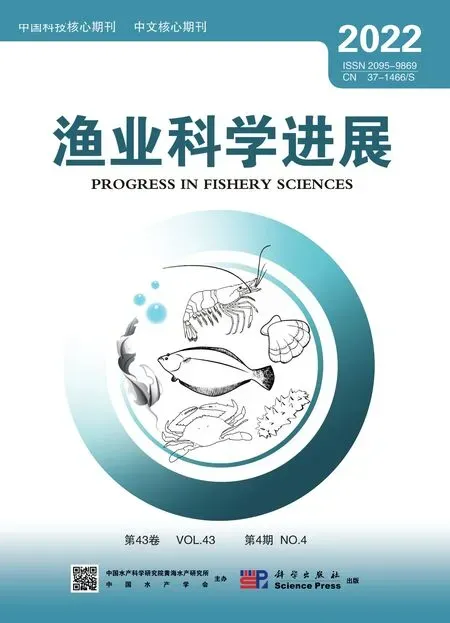长江上游宜宾江段鱼类早期资源现状研究*
李祥艳 田辉伍 蒲 艳 唐锡良 严忠銮 陈大庆 刘绍平 段辛斌
长江上游宜宾江段鱼类早期资源现状研究*
李祥艳1,2田辉伍2蒲 艳1,2唐锡良3严忠銮3陈大庆2刘绍平2段辛斌2①
(1. 西南大学生命科学学院 重庆 400715;2. 中国水产科学研究院长江水产研究所 农业农村部长江中上游渔业资源环境科学观测实验站 湖北 武汉 430223;3. 中国三峡建设管理有限公司 四川 成都 610023)

长江上游;宜宾江段;种类组成;鱼类资源
长江上游地貌类型多样,河床海拔落差大,生境复杂,水能资源丰富,孕育了数量众多的珍稀特有鱼类,历史记载长江上游分布鱼类达286种,其中特有鱼类124种(危起伟, 2012; He, 2010; 孟宝等, 2019)。该流域内具有众多全球和国家保护意义的重要生境和生态敏感区(李德旺等, 2013),其中,长江上游珍稀特有鱼类国家级自然保护区(以下简称保护区)是我国最长的河流型自然保护区,宜宾江段是保护区的核心区,是长江上游许多珍稀特有鱼类的重要栖息地(危起伟, 2012)。
2012年以来,随着向家坝、溪洛渡等大型水库相继蓄水,河流连续性受阻,也阻断了鱼类洄游路径,坝上与坝下群体不能有效进行遗传交流,多样性降低。水文情势发生变化,坝下河流水位流量波动频繁,流水性鱼类栖息生境受到严重影响,不利于鱼类繁殖,资源量下降。下泄水流的含沙量明显减少,坝下河道冲刷和局部河段调整,改变了原有鱼类的繁殖和栖息场所。下泄水温升降滞后,鱼类繁殖时期延迟,种群数量减少(陈大庆等, 2005; 曹文宣, 2017),对长江上游的渔业资源带来了显著影响。高天珩(2016)在长江上游江津江段的研究表明,蓄水后江津江段鱼类卵苗总量有明显下降,圆口铜鱼()、长薄鳅()等大型鱼类在蓄水后未曾监测到。宜宾江段即位于向家坝下,监测断面距向家坝仅约32 km,受大坝建设后水文情势改变的影响更明显。鱼类早期资源的动态变化是引起种群数量变动和年龄结构变化的主要原因(Chambers, 2012),对其的研究也是评估水利工程建设对鱼类资源影响的一个重要手段(徐田振等, 2018),并与渔业资源开发利用尺度及保护政策的制定等密切相关。然而,目前该水域鱼类早期资源的基础资料极少,为此本研究于2017—2019年在长江上游宜宾江段开展鱼类早期资源调查,通过分析种类组成、资源量变化、鱼卵密度与环境因子间的关系,推算产卵场位置和繁殖规模,以期了解宜宾江段早期资源现状,为宜宾江段渔业资源管理和保护提供数据支撑,同时为金沙江下游梯级水电站运行对长江上游鱼类的影响分析提供数据参考。
1 材料与方法
1.1 调查时间与区域
于2017年4月23日—7月15日、2018年4月27日—7月17日和2019年5月7日—7月20日在长江上游宜宾江段开展鱼类早期资源调查,3年累计监测241 d。该断面位于宜宾市叙州区南门大桥上行约400 m处(28°45′N,104°37′E)(图1),上距向家坝水电站约32 km,下距金沙江与岷江交汇口约1.5 km,是保护区的重要部分。采用定点断面的方式进行采样,采样点设置在断面的主流水域的南岸和北岸,该处江岸平直,两岸水流较缓,流速范围为0.46~1.71 m/s,相应江面宽度约260 m。
1.2 采样方法及卵苗鉴定
样品采集按照《内陆水域渔业资源调查手册》和《河流水生生物调查指南》的方法进行(张觉民等, 1991; 陈大庆, 2014)。采集网具为圆锥网(50目,网长为2.5 m,网口面积为0.196 m2),网后接圆柱形集苗器。每天08:00和14:00开始采集,上、下午各采集6网,每网采集15 min。若出现卵苗高峰期,则适当增加采样频率。同时测量水温和溶解氧(YSI ProODO型溶氧仪测定),网口流速(采用LS45A型旋杯式流速仪记录),透明度(使用萨氏盘测定)等环境因子数据,水位和流量数据来源于中国长江三峡集团有限公司水情信息网向家坝站(https://www.ctg.com.cn/ sxjt/sqqk/index.html)。
采集的卵苗在野外先使用奥林巴斯解剖镜SZX16进行观察,记录鱼卵发育时期,测定其卵径、膜径和胚体长,并拍照保存,采用线粒体DNA细胞色素b基因鉴定种类。仔鱼先根据色素的分布、肌节数目等形态特征进行初步种类鉴定(曹文宣等, 2007),后用95%的酒精保存带回实验室进行DNA分子鉴定,以对照校准(Liu, 2018)。
1.3 数据处理与分析
产卵场位置和卵苗径流量等的计算参考易伯鲁等(1998)的计算方法。
1.3.1 产卵场位置推算 根据采集鱼卵的发育时期,并结合水流速度来推算鱼卵的漂流距离和产卵场的位置:
式中,为卵苗的漂流距离(m),为网口流速(m/s),为鱼卵胚胎发育时间(s)。
1.3.2 卵苗径流量估算 一昼夜流经调查断面的卵苗径流量(N),是24 h内各次定时采集的卵苗径流量之和()与前后2次采集之间非采集时间内计算出的卵苗径流量之和(′)的总和,即:
N=′
一次定时采集的断面卵苗径流量(),按下式求出:
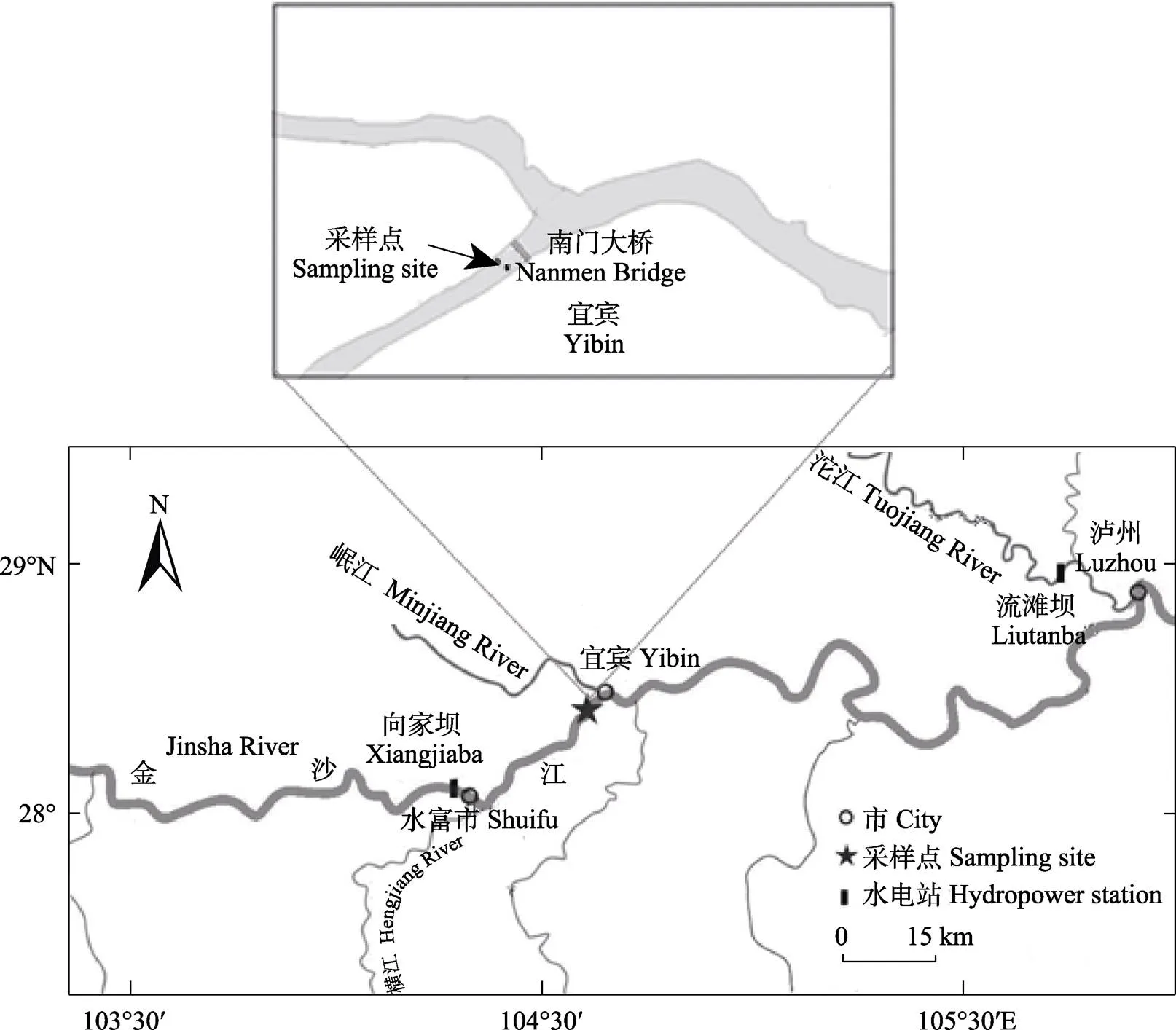
图1 调查断面示意图
(/)
式中,为调查断面的平均江水流量(m3/s),为流经网内的江水流量(m3/s),为断面固定点一次采到的卵苗数量(粒/尾),为断面卵苗流量系数。



(1/12/2)2
式中,为前后2次采集之间的间隔时间,1、2为前后2次采集的持续时间;1、2为前后2次采样的卵苗数量。
1.3.3 统计分析 应用方差分析(ANOVA)检验环境因子的年际变化差异,显著性水平为<0.05。为探究鱼卵密度与各环境因子间的关系,运用束缚型排序(constrained ordination)分析调查数据。水位、流量和水温等环境因子的逐日变化数据作为环境数据源,不同种类的鱼卵密度(ind./1000 m3)逐日变化数据作为物种数据源,由此构成环境因子与物种矩阵。先对物种数据进行除趋势对应分析(detrended correspondence analysis, DCA),表明单峰模型(lengths of gradient>4)更适合本研究,故采用典型对应分析(canonical correspondence analysis, CCA)。DCA和CCA分析和排序图输出均采用Canoco 5软件,其余数据分析与作图在Excel 2010与SPSS软件中完成。
2 结果与分析
2.1 种类组成

2.2 主要鱼类繁殖的时间分布
对2017—2019年调查期间不同鱼类产卵的主要出现时间进行分析,显示不同鱼类繁殖有一定的时间差异,年间也有不同(图2)。

表1 2017—2019年长江上游宜宾江段鱼类早期资源种类组成

Tab.1 Species composition of early fish resources in Yibin Section of the upper reaches of the Yangtze River from 2017 to 2019
注:l代表产漂流性卵鱼类,«代表长江上游特有鱼类
Note: l represents drifting fish, and « represents endemic fish of upper Yangtze River
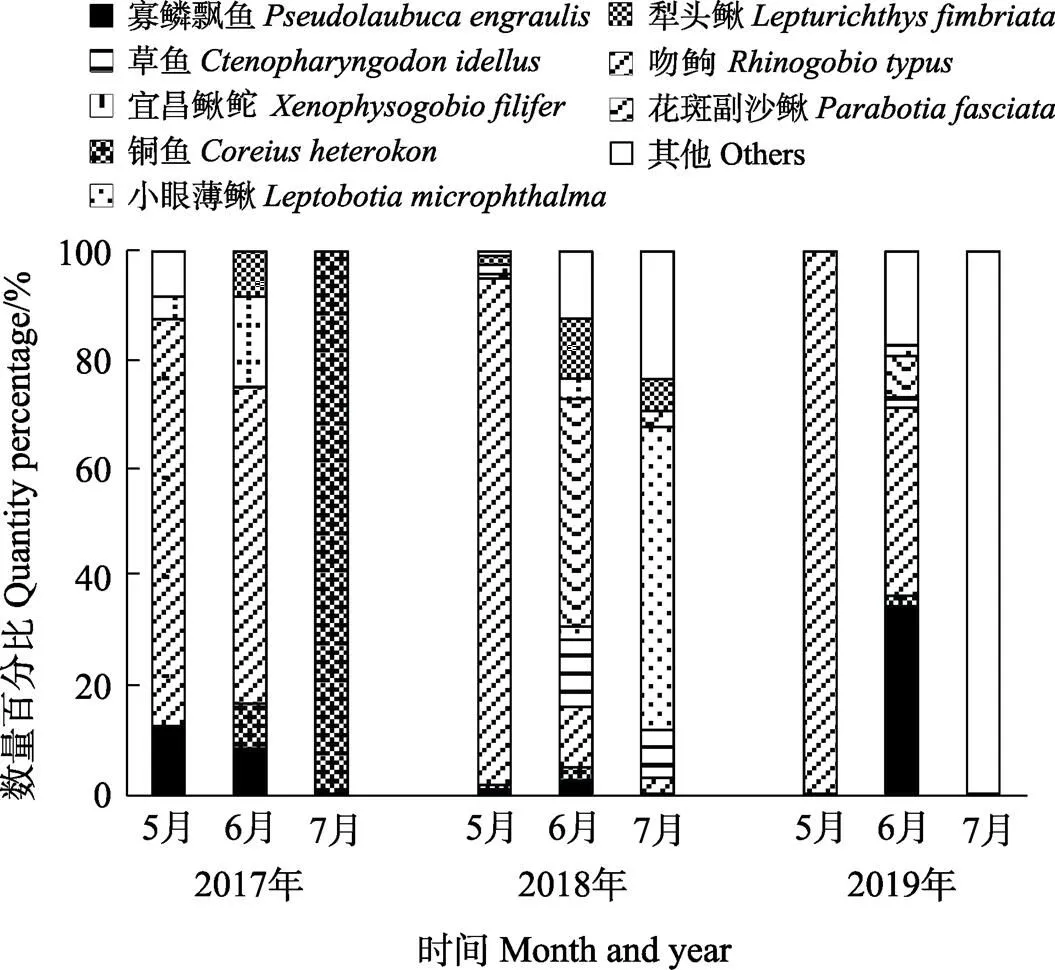
图2 2017—2019年长江上游宜宾江段鱼卵数量百分比
2.3 繁殖高峰
从卵苗密度的日变化来看(图3),鱼卵密度总体上随时间呈现先上升后下降的趋势。2017年鱼卵平均密度为(0.52±0.10)粒/1000 m3,在5月16—24日、5月29日和6月12日达到产卵高峰,其中,以6月12日最高,达到3.91粒/1000 m3;仔鱼平均密度为(0.96±0.32)尾/1000 m3,在6月24日出现峰值,密度为23.56尾/1000 m3。
2018年鱼卵平均密度为(2.49±0.45)粒/1000 m3,在5月6—11日、5月13—16日、5月5月22—24日和6月27—28达到产卵高峰,其中,以6月27日最高,达到24.96粒/1000 m3;仔鱼平均密度为(1.33±0.37)尾/1000 m3,5月22日出现峰值,密度为25.58尾/1000 m3。

图3 2017—2019长江上游宜宾江段鱼卵、鱼苗密度日变化
2019年鱼卵平均密度为(1.24±0.30)粒/1000 m3,在5月12—15日、6月3日、6月14—15日和6月26达到产卵高峰,以6月26日最高,达到21.76粒/1000 m3;仔鱼平均密度为(0.95±0.19)尾/1000 m3,在7月17日出现峰值,密度为7.42尾/1000 m3。
年际对比发现,2018和2019年鱼卵密度显著高于2017年(<0.01),2018年鱼苗密度高于2017和2019年。整体而言,鱼卵密度高峰较为分散,仔鱼密度高峰较为集中,主要以5月下旬或6月下旬较高。
2.4 鱼类早期资源量与产卵场


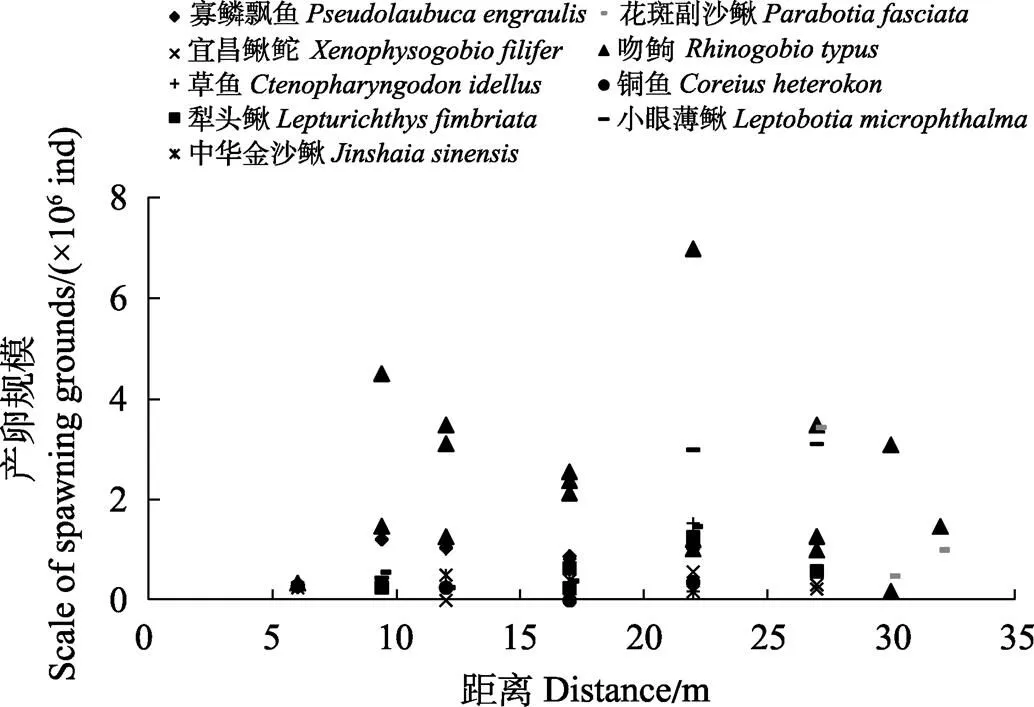
图4 长江上游宜宾段产卵场分布
2.5 鱼卵密度与环境因子
2017—2019年调查期间,宜宾江段各环境因子整体情况如表2所示,流量、水位和水温变化规律表现为整体随时间呈逐渐上升趋势,透明度和溶氧整体随时间呈逐渐下降趋势,流速随时间不断波动,无明显规律(图5)。比较不同年份、同时段各环境因子间的差异,结果表明,流量、水位和水温年际间无显著差异,其他环境因子不同年份间差异显著(<0.05)。
表2 2017—2019年宜宾段环境因子

Tab.2 Environmental factors in Yibin Section from 2017 to 2019
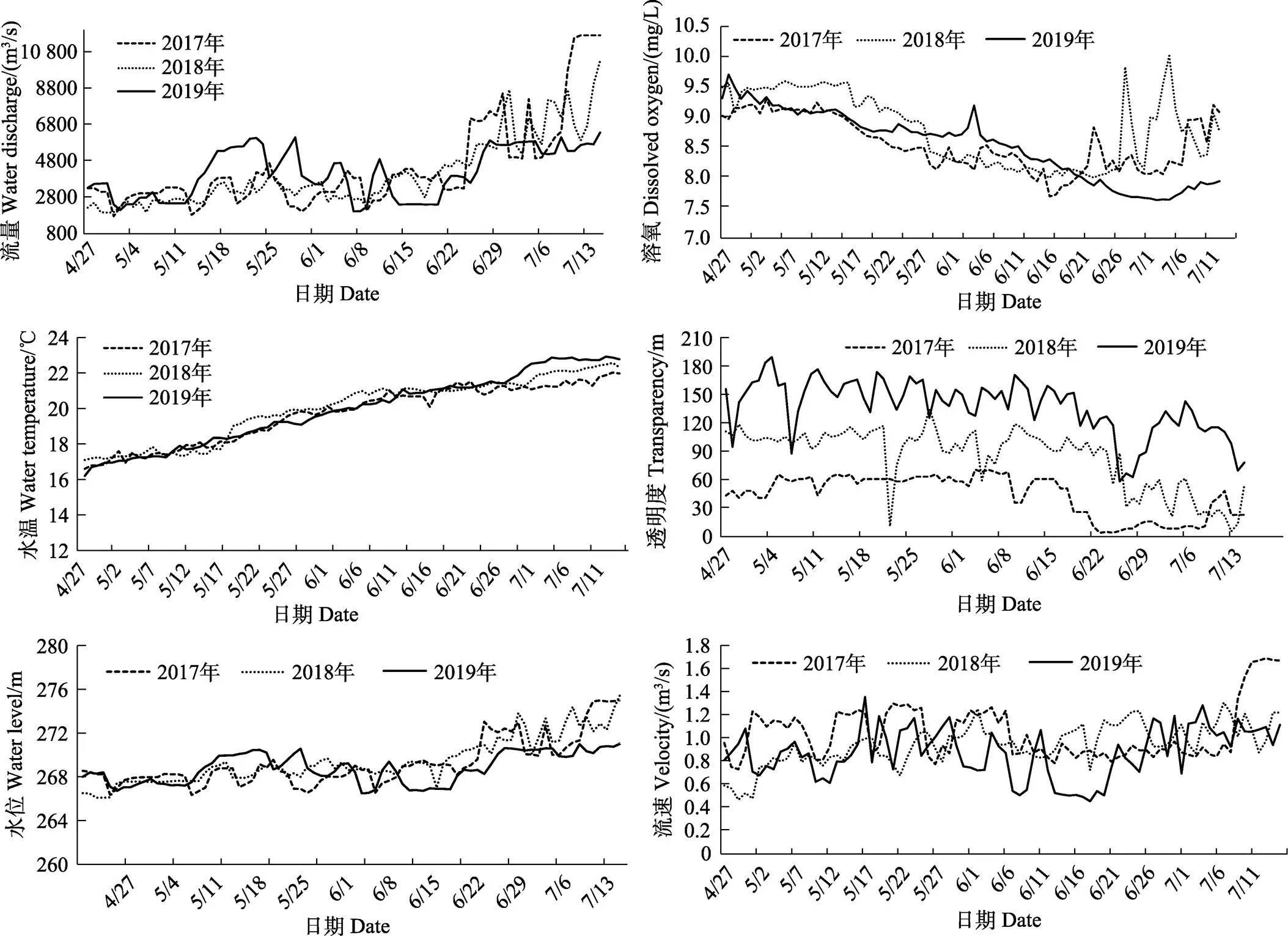
图5 2017—2019年长江上游宜宾江段各环境因子日变化

3 讨论
3.1 种类组成及资源量变化
研究表明,由于水利工程建设、过度捕捞等的影响,宜宾江段鱼类种类数呈下降趋势,并逐渐以小型鱼类为主,产漂流性卵鱼类也有所减少(但胜国等, 1999; 李雷等, 2013; 徐薇等, 2012; 高天珩等, 2013)本研究结果也符合这一趋势变化。而水利工程对鱼类的影响已有大量研究,水坝的修筑会影响下游鱼类繁殖(肖琼, 2015),例如,向家坝截流后长江上游江津江段鱼类早期资源量明显下降(高天珩, 2016)。本研究表明,有22种鱼类能在宜宾江段产卵繁殖,多于上游金沙江巧家和攀枝花江段,但少于江津江段及长江上游支流赤水河和岷江,也少于长江中游(表3),其次,产漂流性卵鱼类数远少于长江上游历史记载的29种,对比显示,长江上游随河段往下,鱼类早期资源种类数逐渐增多,其原因除了上述因素外,与各江段自身水体环境也有一定关系。

图6 2017—2019年长江上游宜宾江段鱼卵密度与环境因子的CCA排序
WL:水位;WT:水温;DO:溶解氧;WD:流量;:流速;:透明度
WL: Water level; WT: Water temperature; DO: Dissolved oxygen; WD: Water discharge;: Velocity;: Transparency

根据2017—2019年早期资源量估算数据,结合有关研究数据[长江上游珍稀特有鱼类及保护区生态补偿项目-水生生态环境监测(2006—2021年度)报告,未正式发表],10年来宜宾鱼类早期资源发生了较大变化(图8)。金沙江Ⅰ期工程蓄水前后,鱼类卵苗总量有明显下降,蓄水后(2013年)比蓄水前(2010年)的鱼类早期资源量下降了80.61%,大坝蓄水造成下游水文环境急剧突变,导致坝下一些鱼类无法适应新的生境,原有产卵场失去功能,自然繁殖受到了影响。同时,蓄水阻断了金沙江与长江上游干流江段的鱼类洄游通道,使长江上游江段渔业资源失去了金沙江鱼类早期资源的补充,这与三峡大坝蓄水后鱼类卵苗数量显著下降的情况相似(刘明典等, 2018)。随后直至2017年,卵苗总量逐渐回升,表明向家坝等水电站蓄水后鱼类逐步完成了对环境的适应,该江段能够满足部分鱼类产卵繁殖的生态需求,可能与该江段仍保留的部分流水生境有关,同时也与近年来长江上游开展的多项鱼类资源保护措施有关。
3.2 产卵场分布
产卵场是鱼类重要的栖息地,产卵场位置的确定是鱼类繁殖群体和卵苗时空分布研究的重要内容,对鱼类资源的补充、可持续利用及保护也有着重要作用(高天珩, 2016)。2009—2015年江津断面早期资源监测结果显示,宜宾至重庆江段分布着多种鱼类的产卵场,且产卵规模巨大(段辛斌等, 2015; 田辉伍等, 2017)。历史记录显示,宜宾境内共有鱼类产卵场36处,珍稀特有鱼类的种类达数10种,但近期产卵场功能评价表明,一般和良好(8.33%)等级共占总数的33.33%,大部分产卵场功能退化,甚至消失(孟宝等, 2019)。本次调查结果显示,宜宾断面上游存在多种产漂流性卵鱼类产卵场,产卵量较大的产卵场有周坝、桃子湾和华龙码头3处,较历史产卵场数量和规模均有减小。

表3 近年长江干支流部分鱼类早期资源调查对比

Tab.3 Comparison of early fish resources in the main and tributaries of the Yangtze River in recent surveys

图7 宜宾段早期资源规模对比
3.3 繁殖特性


4 结论与展望

致谢:感谢长江水产研究所研究生吕浩、王导群、张浩,调查辅助人员田超,宜宾市水产渔政局陈永胜等在野外调查和数据整理等方面给予的支持与帮助。
CAO W X, CHANG J B, QIAO Y,. Fish resources of early life history stages in Yangtze River. Beijing: China Water and Power Press, 2007, 41–252 [曹文宣, 常剑波, 乔晔, 等. 长江鱼类早期资源. 北京: 中国水利水电出版社, 2007, 41–252]
CAO W X. Water ecological protection in the cascade development of hydropower in the upper reaches of the Yangtze River. Technlogy and Economy of Changjiang, 2017, 1(1): 25–30 [曹文宣. 长江上游水电梯级开发的水域生态保护问题. 长江技术经济, 2017, 1(1): 25–30]
CHAMBERS R C, TRIPPEL E. Early life history and recruitment in fish populations. Amsterdam: Springer Science and Business Media, 2012, 173–196
CHEN D Q, CHANG J B, GU H B. Impacts of Jinsha River first stage project on ecology and environment of nature reserve and its countermeasures. Journal of Yangtze River Scientific Research Institute, 2005(2): 21–24 [陈大庆, 常剑波, 顾洪宾. 金沙江一期工程对保护区生态环境的影响与对策. 长江科学院院报, 2005(2): 21–24]
CHEN D Q. Guidelines for river aquatic biology survey. Beijing: Science Press, 2014, 214–236 [陈大庆. 河流水生生物调查指南. 北京: 科学出版社, 2014, 214–236]
DAN S G, ZHANG G H, MIAO Z G,. A survey on the commercial net fishery in the upper reaches of the Yangtze River. Acta Hydrobiologica Sinica, 1999, 23(6): 655–661 [但胜国, 张国华, 苗志国, 等. 长江上游三层流刺网渔业现状的调查. 水生生物学报, 1999, 23(6): 655–661]
DOYLE M J, MORSE W W, KENDALL J A W. A comparison of larval fish assemblages in the temperate zone of the northeast Pacific and northwest Atlantic oceans. Bulletin of Marine science, 1992, 53(2): 588–644
DUAN X B, TIAN H W, GAO T H,. Resources status of ichthyoplankton in the upper Yangtze River before the storage of Jinsha River first stage project. Resources and Environment in the Yangtze Basin, 2015, 24(8): 1358–1365 [段辛斌, 田辉伍, 高天珩, 等. 金沙江一期工程蓄水前长江上游产漂流性卵鱼类产卵场现状. 长江流域资源与环境, 2015, 24(8): 1358–1365]
GAO T H, TIAN H W, YE C,. Diversity and composition of fish in the mainstream of national nature reserve of rare and endemic fish in the upper Yangtze River. Freshwater Fisheries, 2013, 43(2): 36–42 [高天珩, 田辉伍, 叶超, 等. 长江上游珍稀特有鱼类国家级自然保护区干流段鱼类组成及其多样性. 淡水渔业, 2013, 43(2): 36–42]

HE Y, WANG J, LEK A S,. Predicting assemblages and species richness of endemic fish in the upper Yangtze River. Science of the Total Environment, 2010, 408(19): 4211– 4220
JIANG W. Studies on Fish early resources in the main stream of state-level natural protection area for rare and endemic fishes in the upper Yangtze River. Doctoral Dissertation of Institute of Hydrobiology, Chinese Academy of Sciences, 2009 [姜伟. 长江上游珍稀特有鱼类国家级自然保护区干流江段鱼类早期资源研究. 中国科学院水生生物研究所博士研究生学位论文, 2009]
KING M. Fisheries biology, assessment and management. Oxford: Fishing News Books, 1995, 247–248
LEI H, XIE W X, HUANG D M,. The early evolution of the fish with pelagic eggs resources in the upstream of Danjiangkou Reservoir after the cascade development. Journal of Lake Sciences, 2018, 30(5): 1319–1331 [雷欢, 谢文星, 黄道明, 等. 丹江口水库上游梯级开发后产漂流性卵鱼类早期资源及其演变. 湖泊科学, 2018, 30(5): 1319–1331]
LI D W, LI H Q, LEI X Q,. Ecological sensitivity in the upper Changjiang River with GIS technology and hierarchy analysis method. Resources and Environment in the Yangtze Basin, 2013, 22(5): 633–639 [李德旺, 李红清, 雷晓琴, 等. 基于GIS技术及层次分析法的长江上游生态敏感性研究. 长江流域资源与环境, 2013, 22(5): 633–639]
LI L, WEI Q W, WU J M,. Current status of fish assemblages in Yibin reaches of the Yangtze River. Resources and Environment in the Yangtze Basin, 2013, 22(11): 1449–1457 [李雷, 危起伟, 吴金明, 等. 长江宜宾江段渔业资源现状调查. 长江流域资源与环境, 2013, 22(11): 1449–1457]
LIU F, ZHANG F B, WANG X,. Relationships between reproduction activities of fishes with drifting eggs and environmental factors in the Chishui River. Acta Hydrobiologica Sinica, 2019, 43(S1): 77–83 [刘飞, 张富斌, 王雪, 等. 赤水河产漂流性卵鱼类的繁殖活动及其与环境因子之间的关系. 水生生物学报, 2019, 43(S1): 77–83]
LIU M D, GAO L, TIAN H W,. Status of fishes at the early life history stage in the Yichang Section in the middle reaches of the Yangtze River. Journal of Fishery Sciences of China, 2018, 25(1): 147–158 [刘明典, 高雷, 田辉伍, 等. 长江中游宜昌江段鱼类早期资源现状. 中国水产科学, 2018, 25(1): 147–158]
LIU M D, WANG D Q, GAO L,. Species diversity of drifting fish eggs in the Yangtze River using molecular identification. PeerJ, 2018, 6: e5807
LÜ H, TIAN H W, SHEN S W,. The larval resources of fishes spawning drifting eggs in the lower reaches of the Minjiang River. Resources and Environment in the Yangtze Basin, 2019, 28(3): 586–593 [吕浩, 田辉伍, 申绍祎, 等. 岷江下游产漂流性卵鱼类早期资源现状. 长江流域资源与环境, 2019, 28(3): 586–593]
MENG B, ZHANG J F, YE H,. Current situation and protection enlightenment of the function of fishing spawning grounds in the national nature reserve for the rare and endemic fishes, upper reaches of the Yangtze River. Resources and Environment in the Yangtze Basin, 2019, 28(11): 2772–2785 [孟宝, 张继飞, 叶华, 等. 长江上游珍稀特有鱼类国家级自然保护区鱼类产卵场功能现状分析及保护启示. 长江流域资源与环境, 2019, 28(11): 2772– 2785]
PAVLOV D S. The downstream migration of young fishes in rivers: Mechanisms and distribution. Folia Zoologica, 1994, 43(3): 193–208
SHEN Y C. Culture and enhancement of fish. Beijing: Agriculture Press of China, 2008 [申玉春. 鱼类增养殖学. 北京: 中国农业出版社, 2008]

WANG D Q, TIAN H W, TANG X L,. Early fish resources of drifting egg fish in Panzhihua Section of Jinsha River. Freshwater Fisheries, 2019, 49(6): 41–47 [王导群, 田辉伍, 唐锡良, 等. 金沙江攀枝花江段产漂流性卵鱼类早期资源现状. 淡水渔业, 2019, 49(6): 41–47]
WEI Q W. Scientific investigation report on the national nature reserve for the rare and endemic fish in the upper reaches of the Yangtze River. Beijing: Science Press, 2012, 3–251 [危起伟. 长江上游珍稀特有鱼类国家级自然保护区科学考察报告. 北京: 科学出版社, 2012, 3–251]
WU G X, LIU L H, WANG Z L,. Studies on natural reproduction ofin the Jinsha Section of the upper Yangtze River. Freshwater Fisheries, 1988(1): 3–6 [吴国犀, 刘乐和, 王志玲, 等. 长江上游金沙江江段草鱼自然繁殖的研究. 淡水渔业, 1988(1): 3–6]
XIAO Q. The effect of water conservancy project in the downstream of Jinsha River of the change of Cobitidae. Master′s Thesis of Hunan Agricultural University, 2015, 13–16 [肖琼. 金沙江下游水利工程对鳅科鱼类的变动影响. 湖南农业大学硕士研究生学位论文, 2015, 13–16]
XU T Z, LI X H, LI Y F,. Status of early resources in Yujiang Jinling River Section. South China Fisheries Science, 2018, 14(2): 19–25 [徐田振, 李新辉, 李跃飞, 等. 郁江中游金陵江段鱼类早期资源现状. 南方水产科学, 2018, 14(2): 19–25]
XU W, QIAO Y, GONG Y T. Changes of fish resources in upper Yangtze River and its protection. Yangtze River, 2012, 43(1): 67–71 [徐薇, 乔晔, 龚昱田. 长江上游鱼类资源变迁及其保护评析. 人民长江, 2012, 43(1): 67–71]
YI B L, YU Z T, LIANG Z S,. The distribution, natural conditions and breeding production of the spawning grounds of four famous freshwater fishes on the main stream on the Yangtze River. In: YI B L, YU Z T, LIANG Z S,. Gezhouba water control project and our famous fishes in Yangtze River. Wuhan: Hubei Science and Technology Press, 1988, 1–46 [易伯鲁, 余志堂, 梁秩燊, 等. 长江干流草、青、鲢、鳙四大家鱼产卵场的分布、规模和自然条件. 见: 易伯鲁, 余志堂, 梁秩燊, 等. 葛洲坝水利枢纽与长江四大家鱼. 武汉: 湖北科学技术出版社, 1988, 1–46]
ZHANG J M, HE Z H. Handbook of fisheries natural resources investigation in inland waters. Beijing: Agriculture Press of China, 1991, 1–461 [张觉民, 何志辉. 内陆水域渔业自然资源调查手册. 北京: 中国农业出版社, 1991, 1–461]
ZHOU H H, TIAN H W, HE C. Surveys for resources of drifting eggs fish at early life history stages in the Qiaojia Section in the lower reaches of the Jinsha River. Resources and Environment in the Yangtze Basin, 2019, 28(12): 2910–2920 [周湖海, 田辉伍, 何春, 等. 金沙江下游巧家江段产漂流性卵鱼类早期资源研究. 长江流域资源与环境, 2019, 28(12): 2910–2920]
Study on the Status of the Early-Stage Fish Resources at Yibin Section in the Upper Reaches of the Yangtze River
LI Xiangyan1,2, TIAN Huiwu2, PU Yan1,2, TANG Xiliang3, YAN Zhongluan3, CHEN Daqing2, LIU Shaoping2, DUAN Xinbin2①
(1. College of Life Science, Southwest University, Chongqing 400715, China; 2. Fishery Resources and Environmental Science Experimental Station of the Upper-Middle Reaches of Yangtze River, Ministry of Agriculture and Rural Affairs, Yangtze River Fisheries Research Institute, Chinese Academy of Fishery Science, Wuhan, Hubei 430223, China; 3. Three Gorges Construction Management Co., Ltd, Chengdu, Sichuan 610023, China)
To understand the status of early-stage fish resources in the Yibin Section in the upper reaches of the Yangtze River and guide the protection of fish resources in this section, surveys were carried out from April to July in the years of 2017~2019. The results showed that there were 22 species of eggs and larvae in five families and three orders, and the largest proportion was in the Cyprinidae. Among these, 13 species produced drifting eggs, and six species were endemic to the upper reaches of the Yangtze River. The breeding time of different fish had obvious annual differences, but the peak of fish breeding occurred in June. From 2017 to 2019, the number of drifting eggs was estimated to be 12.10×106, 70.42×106, and 35.77×106for each year, respectively. The number of larvae was estimated to be 30.95×106, 41.47×106, and 39.44×106, respectively. The number of eggs of endemic fish in the upper reaches of the Yangtze River was estimated at 15.91×106over three years. According to the calculation, there were many spawning sites of fish drifting upstream of the Yibin Section, and the larger spawning sites were mainly located in the reaches of Zhouba, Peachwan, and Hualong Wharf. The spawning sites ofwere distributed from Dongyuemiao to Xiangjiaba, with the largest cumulative spawning amount in three years, up to 40.93×106. The spawning grounds oftended to migrate downstream. The spawning grounds ofare mainly distributed in the Mamingxi Wharf and Peachwan areas. The results of the canonical correlation analysis showed that environmental factors such as water level, water temperature, and water discharge had different effects on the density of drifting fish eggs.andlay eggs when the water temperature and water discharge are high. The reproductive conditions ofandwere similar to each other, and they were highly correlated with the water level, water discharge, and velocity. The spawning ofandwas significantly affected by changes in dissolved oxygen and transparency. Although affected by many factors, such as the development of cascade hydropower in the Jinsha River, the Yibin Section, as an important part of the mainstream national nature reserve of rare and endemic fish in the upper Yangtze River, is still a crucial distribution area for the spawning and breeding of many fish species, and the fish populations have slowly recovered in recent years. Therefore, we should strengthen the early resource research in this section, carry out habitat conservation and remediation, and implement a “10-year Fishing Ban” to promote resource recovery.
Upper Yangtze River; Yibin Section; Species composition; Fish resource
DUAN Xinbin, E-mail: duan@yfi.ac.cn
10.19663/j.issn2095-9869.20210319002
S932.4
A
2095-9869(2022)04-0093-12
*国家重点研发计划(2018YFD0900903)、中国三峡建设管理有限公司项目(JG/18056B; JG/18057B)、中国水产科学研究院创新团队项目(2020TD09)、农业农村部财政专项“长江渔业资源与环境调查”和生态环境部生物多样性调查、观测和评估项目(2019—2023年)共同资助[This work was supported by National Key Research and Development Program of China (2018YFD0900903), Project of Three Gorges Construction Management Co., Ltd (JG/18056B; JG/18057B), Innovation Team Project of Chinese Academy of Fishery Sciences (2020TD09), Ministry of Agriculture and Rural Affairs, and the Biodiversity Investigation, Observation, and Assessment Program (2019—2023) of the Ministry of Ecology and Environment of China].
李祥艳,E-mail: lxyqin96@163.com
段辛斌,研究员,E-mail: duan@yfi.ac.cn
2021-03-19,
2021-05-10
http://www.yykxjz.cn/
李祥艳, 田辉伍, 蒲艳, 唐锡良, 严忠銮, 陈大庆, 刘绍平, 段辛斌. 长江上游宜宾江段鱼类早期资源现状研究. 渔业科学进展, 2022, 43(4): 93–104
LI X Y, TIAN H W, PU Y, TANG X L, YAN Z L, CHEN D Q, LIU S P, DUAN X B. Study on the status of the early-stage fish resources at Yibin Section in the upper reaches of the Yangtze River. Progress in Fishery Sciences, 2022, 43(4): 93–104
(编辑 冯小花)

